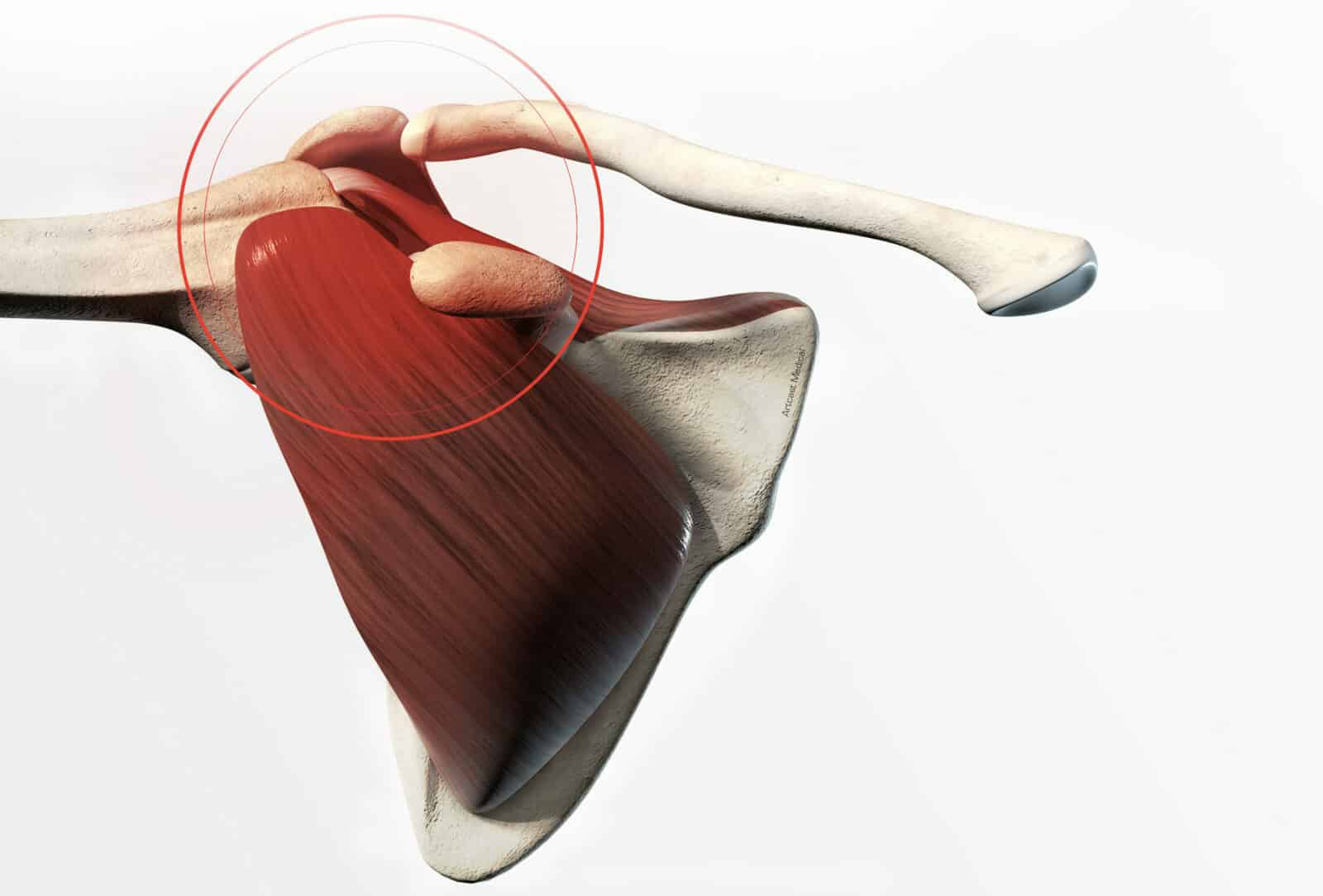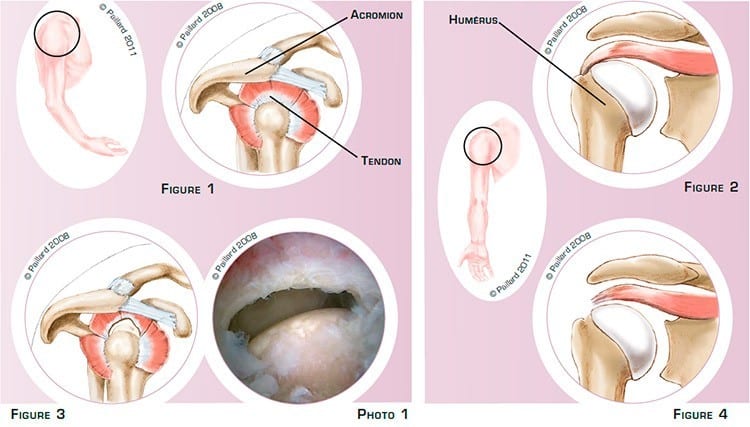Rotator cuff repair
You have a ruptured rotator cuff
You are going to undergo arthroscopic repair of the shoulder tendons

You have a ruptured rotator cuff
You are going to undergo arthroscopic repair of the shoulder tendons
Rotator cuff repair
The shoulder is the joint between the scapula and the humerus. The tendons connecting the muscles to the bone are the rotator cuffs. They are attached to the head of the humerus and participate in the lifting movements of the arm and rotation of the shoulder. The acromion is part of the scapula that forms an arch above the joint (figures 1 and 2).
When lifting the arm, the tendons hit and rub against a projection on the acromion, which sometimes forms a bone spur. This repeated contact can lead to the rupture of the tendons (figures 3 and 4 and photo 1).
The rupture of one or several tendons causes pain and a decrease in active mobility and strength in the shoulder, as well as difficulty in lifting the arm.

The natural progression of a ruptured tendon in the shoulder is the gradual worsening of the rupture resulting in greater discomfort, a tendon that is more difficult to repair and therefore a more uncertain result.
The aim of rotator cuff repair is to relieve the pain, recover shoulder strength and mobility and thus help prevent the progressive deterioration of the joint.
Rotator cuff repair consists in anchoring the ruptured tendon to its natural site around the head of the humerus. This procedure is performed arthroscopically, that is, without opening the joint. Arthroscopy spares the anatomical structure and the joint can be accessed without damaging the muscles.
This technique therefore has proven advantages in relation to traditional surgery, including minimal blood loss and faster post-operative recovery. Several small 5-mm incisions are made around the shoulder. An arthroscope, or small camera, is inserted through one of the incisions to view the joint and in particular the ruptured tendon. Small instruments are inserted through the other incisions to perform the surgery.

The surgical procedure involves several steps :
First, the shoulder is cleaned and the inflamed tissue is resected. The bone and the tendon are exposed and prepared for repair. One or several anchors are screwed to the humerus (figure 5).
The sutures from these anchors are then used to tie the tendon to the bone (figures 6 and 7, photo 2). An acromioplasty, that is, the resection of the bone projection on the acromion, is then carried out to create more space and prevent excessive contact with the tendon (figure 8 and 9).


The operation lasts about 1 hour, but can last longer according to the extent of the damage and the number of tendons to be repaired, and it requires 2 to 3 days in hospital.
This operation is carried out under regional or general anaesthesia. Your anaesthesiologist will decide with you the best type of anaesthesia according to your state of health.
After the operation, the incisions are covered with a sterile dressing, which is left in place for 10 days. The pain will be managed and monitored very closely during the post-operative period, and the treatment will be adjusted accordingly. A shoulder immobilizer sling will be used to immobilize and protect your shoulder for 6 weeks to allow time for tendon-to-bone healing.
For the first 2 weeks after the operation, you will perform pendular movements several times a day yourself to moderately and passively mobilize your shoulder.
From the 3rd to the 6th week post-op, you will start a more intensive passive rehabilitation programme with your physiotherapist; he will move your arm.
After the 6th week post-op and the check-up with your surgeon, you will be able to remove the sling definitively and start active mobilization of the shoulder. The aim of the work with your physiotherapist is to recover active mobility and muscle strength of the shoulder, that is, the capacity to lift your arm yourself. This will progressively train the repaired muscles and enable you to resume your daily activities and sport.
It is often necessary to wait until the 3rd month before driving again. You can generally return to work between the 3rd and the 6th month, depending on your profession. If you work in an office, you may be able to return to work more rapidly after the operation.
In addition to the risks associated with any surgery and the anaesthetic, there are some risks specific to this surgery :
This list of risks is not exhaustive. Your surgeon can provide you with any additional explanations and will be available to discuss the advantages, disadvantages and risks of the operation with you.
Tendon-to-bone healing is only obtained in about 60 to 80 % of cases. Healing depends on several factors such as the size and age of the rupture, the quality of the tendon and even age. If the tendon does not heal to the bone, there may not be any difference in terms of the pain, but the shoulder may not recover its full strength.
The results of this technique are nevertheless very encouraging as pain relief and an improvement in shoulder function are observed in over 90 % of cases. The time the pain takes to disappear varies. Complete recovery of mobility and muscle strength generally takes about 3 to 6 months.
Laissez votre commentaire